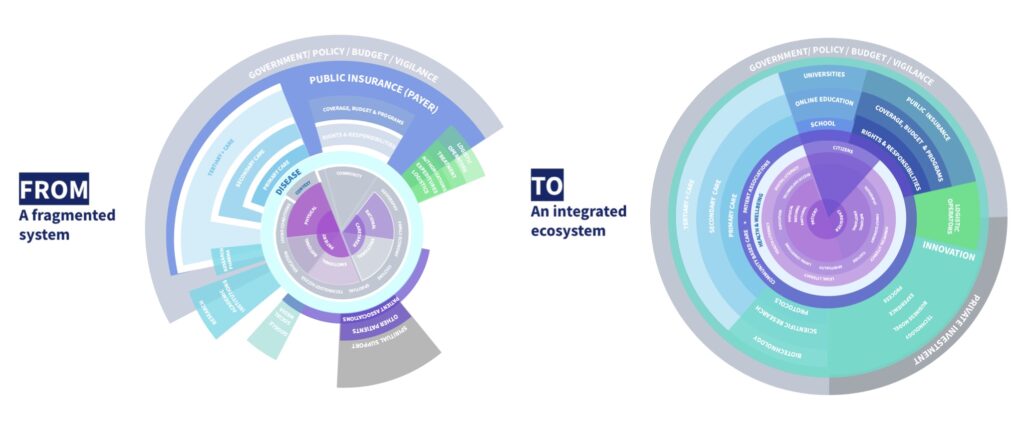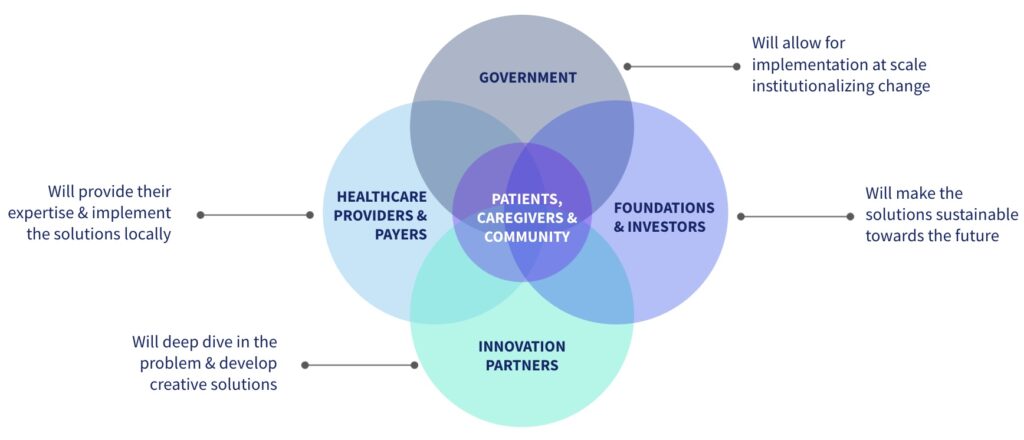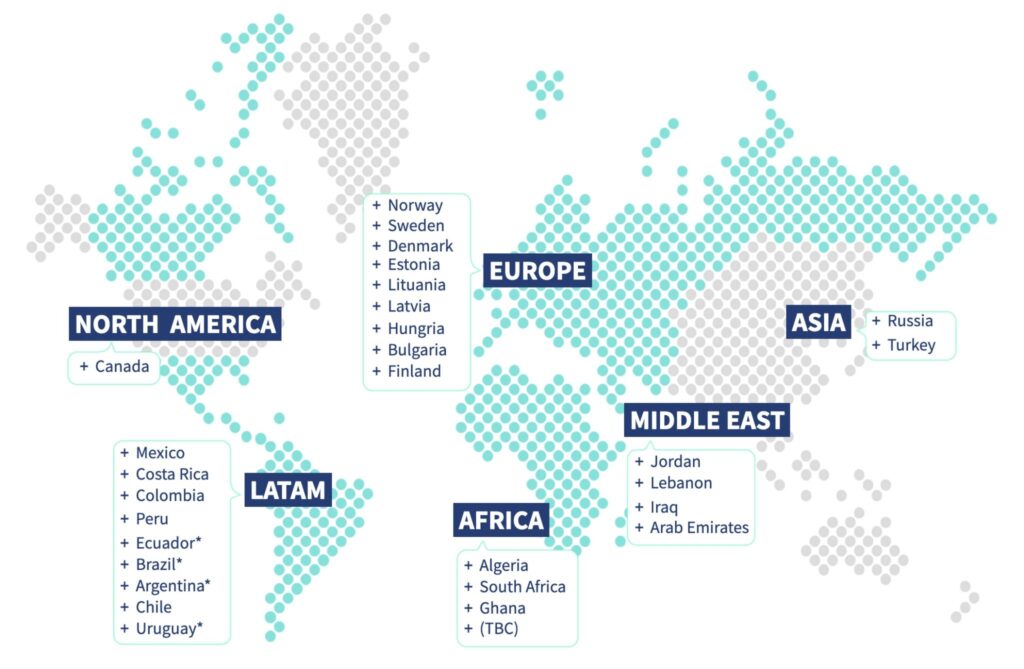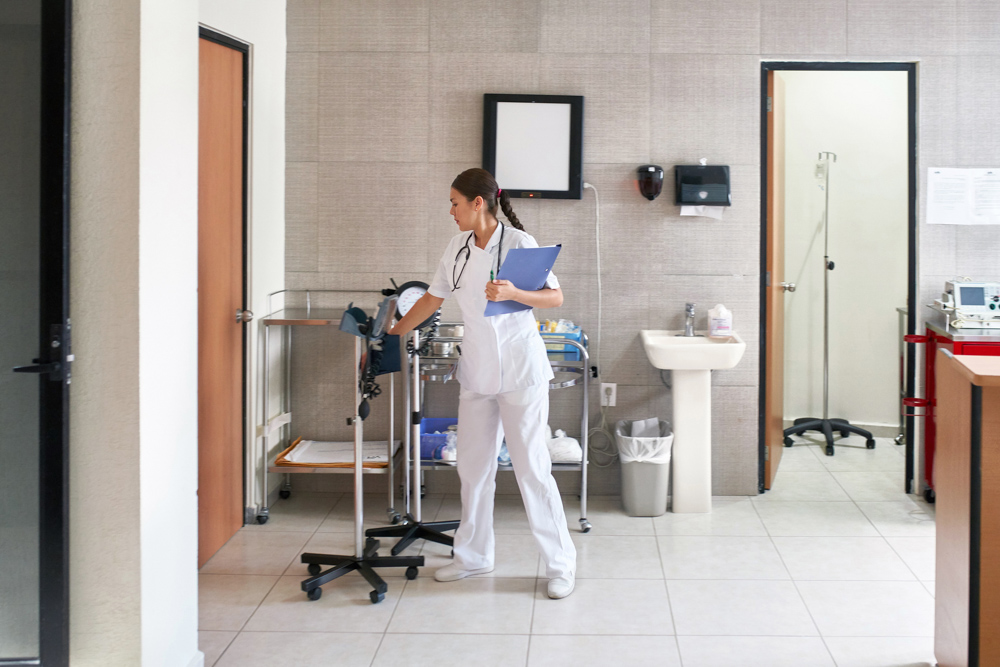Movement Health 2030: building sustainable healthcare ecosystems
Movement Health 2030: building sustainable healthcare ecosystems, based on local partnerships, in collaboration with Roche.
- Roche
- Healthcare
Transforming
health ecosystems
Roche is on a mission to innovate and build strong and scalable healthcare ecosystems around the world. Transforming healthcare ecosystems, and tackling some of the largest health issues across the world is not a challenge that can be solved by one company or organization alone. Rather, it requires long-term partnerships with various stakeholders and experts across the ecosystem.
Roche launched Movement Health 2030 in 2019 with The Copenhagen Institute of Future Studies and guided by Harvard Health System professor Rifat Atun to accelerate the progress of developing new solutions and transforming health systems in communities around the world.
Board of Innovation entered this partnership to act as the innovation partner, to co-design, help implement, and scale this global movement.
Movement Health 2030 aims to achieve system change in two complementary ways:
1.By achieving policy changes that enable better use of resources through technologies that positively impact health outcomes. This enables innovations to be used and/or improves health efficiencies.
2.By solving health system issues in countries or regions with innovation challenges, which leads to pilot projects and igniting policy shifts via concrete proof-of-concepts.
Movement Health 2030 was created with the 2030 United Nations Sustainable Development Goals (SDGs) firmly in mind. To ensure that the Movement has a tangible and measurable impact worldwide, it is developing an evaluation framework closely aligned to the SDGs.
Movement Health 2030
innovation perspective
Building sustainable healthcare ecosystems
Movement Health and its partners are on a mission to build sustainable and integrated healthcare ecosystems around the world. With a unique approach to building local ecosystems and connecting partners across regions, Movement Health is developing a network to accelerate scalable solutions.
Movement Health has co-developed and defined the initiative and the approach to building transformative partnerships, and continues to implement the impact framework to develop disruptive yet inclusive solutions through open innovation.

Change through
collaboration
Movement Health is a collaborative platform that works with the local ecosystems, coordinating them in a self-empowered way to create new, more sustainable, and patient-centric healthcare solutions. That approach requires a radical shift in mindset.
Movement Health connects healthcare providers, policymakers and entrepreneurs in each of the participating countries, to identify bottleneck issues and solutions to key health challenges. Drawing on insights generated through roundtables with high-level stakeholders and the varied expertise of regional advisory boards, Movement Health aims to map a pathway to more equitable, resilient and effective health systems across the world. Public sector stakeholders are engaged from the onset to help shift policy frameworks towards being more supportive of innovation ecosystems; this way innovators can focus their entrepreneurial energy on solutions that they know governments are willing to prioritise and help scale. This way, Movement Health is interlinking policy and innovation, understanding that one cannot thrive without the other.
Working in collaboration with local networks, Movement Health helps to develop, pilot, scale and evaluate solutions that address pressing healthcare issues, and ensure that they have the active policy support needed to have a meaningful impact. The goal is to scale successful pilots locally and across countries to stimulate evidence-based healthcare system transformation. By stimulating multi-stakeholder collaboration, opening up high-level conversations about regional healthcare challenges, and deploying scalable pilots, Movement Health aims to enact the policy and operational changes required to unlock access to better healthcare for all.
The steps towards healthcare of the future
By bringing together local partners and innovators, Movement Health wants to have an impact at the local level of the healthcare systems. Drawing on unique insights and perspectives from each healthcare market, Movement Health can shape and deliver relevant systemic transformations that have rapid, scalable, sustainable, and global impact. Sounds promising, but how exactly does it work?
First of all, by working together with local partners, and identifying their specific needs. Secondly, by developing a global network focused on innovation, to significantly reduce health-related challenges for people everywhere. And thirdly, by committing partners to run pilot projects on new healthcare solutions, where there is an unmet need.
Let’s take a closer look at its ambitions and vision. Which challenges does it address? How does impact through systemic innovation work? And what lies ahead in the future?

The challenges facing healthcare today
Healthcare systems today face multiple challenges, but the single biggest challenge is access to care. Movement Health 2030 focuses on four key areas to rebuild healthcare ecosystems with a human-centric perspective.
Lifelong quality of care: new patient-centric care models are needed to prevent and diagnose faster and treat closer to the patient. Patient empowerment and involvement is central to this model.
Data science and digital solutions: break down access barriers and enhance the capabilities of healthcare systems, through smart data integration, advanced analytics, and automation.
Creating inclusive partnerships: new solutions to reduce waste, distribute care effectively, and shift power dynamics.
Readiness for bioscience innovation: scaling bioscience innovation to ensure equitable and cost-effective access, globally.
Movement Health 2030 aims to create a more sustainable healthcare architecture. One that is driven by the need to solve problems that have affected patients for decades. By bringing partners together, it wants to develop solutions that can solve the most pressing challenges in healthcare today – with measurable systemic change and tangible local impact.
Understanding the way of working; the movement
in action
Step 1: regional setup
With each participating country, the Movement starts with the identification of local committed partners, willing to run the initiative locally. Movement Health runs local ecosystem and innovation mapping to identify these partners and the opportunities and synergies.
The goal is to identify partners with transversal perspectives that can map out the needs of patients and the healthcare ecosystem as a whole, both current and long-term.
Step 2: focus area and problem space definition
Together with diverse, local experts from different parts of the healthcare ecosystem, a roundtable exercise is carried out. The roundtable looks at the possible gaps that might occur when trying to solve a patient need. What would be needed in order to improve healthcare in a certain region – and what would be the pitfalls? The outcome is the identification of the long-term key challenges and opportunities for change.
Depending on the regional priority, a specific focus is chosen as the starting point. For LATAM, for example, the focus area is “Lifelong quality of care”.
From the roundtable outcomes, the regional board will design regional strategic imperatives to guide the priorities of the region.
Step 3: building local networks
Throughout the process, Movement Health focuses on working with local experts, entrepreneurs, board members and other committed partners; engaging with the right partners is key to enable concrete actions and tangible results.
Movement Health focuses on building local synergies and leveraging existing initiatives and capabilities to identify the areas where Movement Health 2030 can be a strategic partner for governments and healthcare systems.
Step 4: open innovation
Defining innovation challenges with local partners and scouting for existing capabilities and solutions. Co-creating and accelerating healthcare innovation solutions that are piloted at a small scale.
Step 5: policy shift
Defining innovation challenges with local partners and scouting for existing capabilities and solutions. Co-creating and accelerating healthcare innovation solutions that are piloted at a small scale.
Step 6: scalability
Identifying synergies between solutions regionally and globally to leverage learnings and solutions to accelerate change.
LATAM as an example; brining in crucial expertise
Movement Health 2030 was first launched in LATAM. There, the Movement brought in the expertise of 63 specialists from different parts of the healthcare ecosystem, from nine different Latin-American countries. Together, they shed light on the issues, providing a multi-stakeholder perspective. After that, a regional advisory board with experienced thought leaders from different parts of society was set up. These included healthcare institutions, members of Government, and the Copenhagen Institute for Future Studies, bringing in the visionary perspective.
That broad vision offered a diverse perspective and global mindset. And it’s what makes the program so rich and promising. It merges a variety of insights and expertise while keeping the decision-making at a local level to fully address the local needs in healthcare.
The impact
A long-term approach to healthcare impact
Movement Health wants to make a lasting impact and to achieve this, it relies on four pillars:
Local focus, global vision. First, it wants to design a vision of healthcare that is in harmony with the local healthcare ecosystem. What are the needs of patients, doctors, hospitals, and other healthcare providers in a certain region, at a certain point – and how can collaboration assist in overcoming them?
Identifying healthcare challenges. Secondly, it aims to identify potential healthcare challenges that deserve to be picked up by the broader stakeholder network. How can a global network of innovators and partners help to address local challenges – and better patients’ lives?
Engaging the entire ecosystem to find solutions. Thirdly, it wants to highlight existing solutions, engaging innovators and tech solutions from around the world to take part in pilot programs with grassroots partners. How can we develop solutions to help local partners, by matching them with the right innovators and partners – and develop a tailored approach to the issues?
Creating a mindset shift. Lastly, the Movement aims to create a mindset shift from the bottleneck challenges, by engaging in different activities related to policy.
These pillars require a regional partnership framework with like-minded and interested stakeholders. It brings countless partners to the table, from private companies to tech companies, healthcare ecosystem players, public institutions, and beyond. By developing and launching innovation challenges and pilots together, they can benefit the local healthcare systems. Each of them are focused on solving regional problems, using a local approach – which increases the chances of success significantly.
The movement is growing
Movement Health is now active in Latin America, Middle East, Africa, Russia, Turkey, Canada, and Europe. The Movement has succeeded in engaging external stakeholders from the healthcare ecosystem. It has successfully built partnerships at local, regional, and global levels with different outcomes from each region. These outcomes vary from pilot launches to policy activities. In each country, the Movement is working on identifying and generating solutions to solve the unmet patient and ecosystem needs.

Chile: the first business case
The first business case of the Movement can be found in Chile. Here, Movement Health 2030 launched a pilot with a public-private collaboration. It engaged and gathered stakeholders from across the healthcare ecosystem to partner on creating impactful healthcare solutions. These stakeholders included tech companies, healthcare institutions, biobanks, and local entrepreneurs with the knowledge of adopting a solution at a local level. Roche brings the expertise and knowledge of the healthcare ecosystem, while the Government’s representative brings the policy perspective to the table.
These partners met to discuss the key healthcare challenges in their regions and how to solve them while creating value for the ecosystem. With that shared value in mind, they discussed the roadmap of existing or new solutions that could be implemented within the right context.
The partners agreed on the scope, KPIs, shared value, and milestones they wanted to achieve. After that, they created a contract to demonstrate commitment to launch their one-year pilot project. In Chile, the pilot focused on improving interoperability and efficiencies between institutions.
Innovating in this way, focusing on local partnerships, takes time. With the Movement’s launch in Latin America, we learned that it is crucial to adapt its approach to each region’s priorities at the country level.
Moreover, involving local entrepreneurs with specific country knowledge, from day one, is crucial to the success and implementation of the pilot solutions. Each country and region is unique and deserves its own approach and solutions. Regulations vary from region to region, and healthcare isn’t standardized everywhere.
The road less travelled leads to new approaches

Innovating in this way, focusing on local partnerships, takes time. With the Movement’s launch in Latin America, we learned that it is crucial to adapt its approach to each region’s priorities at the country level.
Moreover, involving local entrepreneurs with specific country knowledge, from day one, is crucial to the success and implementation of the pilot solutions. Each country and region is unique and deserves its own approach and solutions. Regulations vary from region to region, and healthcare isn’t standardized everywhere.
The local and global perspective
Movement Health 2030 can only thrive with a philosophy of creating a concrete local impact while stimulating broader systemic change on a global level. This means stimulating local stakeholders and bringing in local expertise to identify innovation focus areas and support them through the launch of pilot programs and the scaling of solutions.
At the same time, it’s key to develop a global strategy to scale internationally and grow the Movement. True impact, with long-lasting results.
What's next for movement health
In each engaged region, Movement Health is at different stages. In Latin America, MH2030 wants to analyze and consolidate the results of the pilot programs it has already rolled out, and map out potential policy shifts. The EMEA launch will benefit from the project’s experiences in Latin America. But as we said, every country is unique and requires its own approach. In Europe, for example, the Movement will focus on launching cross-country pilots. Given the maturity of the healthcare system, the challenges being experienced are different.
Pilots to pave the way
In the next three years, healthcare providers, policymakers and entrepreneurs from 57 countries across 5 continents will have joined Movement Health. Movement Health 2030 will have run 80 pilots focused on transforming healthcare services. These pilots will continue to be combined with policy and regulation transformation, and successful pilots will be scaled across borders, facilitated by policymakers, global organizations, and healthcare companies, all working toward one goal: better healthcare for all. While the pilots are localized, global scaling is pre-considered in the solution design and facilitated by a network of international leaders.
And pilots are just the beginning… The results of the pilots will stimulate meaningful, evidence-based proposals for transforming the healthcare ecosystems and suggest policy and operational evolution. This will unlock access to better healthcare for all.
"Movement Health 2030 members envision a future of healthcare solutions that make better lifestyle an opportunity for all. During the pandemic, companies, experts, innovators, and governments have found unprecedented ways of working together that are here to stay. Movement members leverage the strengths of each other to test and scale the opportunities to modernize healthcare with a human-centered perspective"
Hector Pourtale, Head of Movement Health 2030 at Roche
Roche x Board of Innovation projects
Project
Accelerating the innovation process with a shared knowledge platform and a solid innovation framework, aimed at solving the unmet patient needs.
Project
Project
Board of Innovation is working with Roche across their innovation journey, transforming healthcare ecosystems with an outside-in approach and solving the unmet needs of patients.


